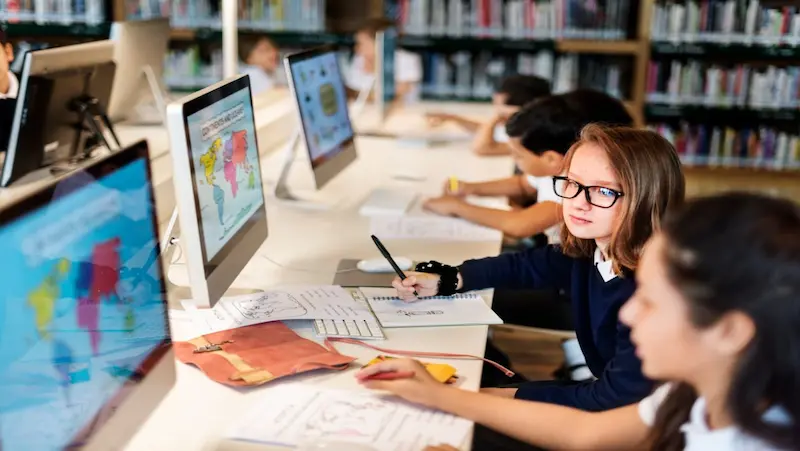In today’s fast-paced world, technology has become an integral part of our daily lives, shaping the way we learn and interact with the world around us. Nowhere is this more evident than in the realm of education, where technology plays a pivotal role in shaping the learning experiences of our youngest generation. For children, the integration of technology in education goes beyond just gadgets and screens; it opens up new avenues for exploration, creativity, and engagement. This shift has transformed traditional classrooms into dynamic learning environments, fostering a generation of tech-savvy learners ready to navigate the challenges of the 21st century. Let’s delve into the fascinating journey of how technology is revolutionizing education for our children.
Table of contents
Benefits of Technology in Education
In the ever-evolving landscape of education, technology has become a game-changer, opening up new avenues for learning and transforming the way students engage with the process.

Enhancing Engagement and Interactivity
Remember those days when a teacher would write on the blackboard, and students would try to stay attentive, but sometimes attention wandered? Well, technology has injected a dose of excitement into learning. Interactive whiteboards, educational apps, and online platforms bring lessons to life, making them more engaging.
Imagine a history class where instead of just reading about ancient civilizations, students virtually explore the ruins of Rome or the Great Wall of China. Technology doesn’t just tell students about the world; it lets them experience it, creating a dynamic and immersive learning environment that captures attention and fosters genuine curiosity.
Personalized Learning Experiences
One size doesn’t fit all, especially in education. Each student is unique, with different strengths, weaknesses, and learning styles. Technology recognizes this diversity and allows for a personalized approach to learning.
Adaptive learning platforms use data and algorithms to tailor lessons to individual students, ensuring they grasp concepts at their own pace. If a student excels in one area but struggles in another, technology can adjust the learning materials to provide extra support where needed. This personalized touch not only boosts understanding but also nurtures a student’s confidence and love for learning.
Access to a Vast Range of Educational Resources
Gone are the days of being confined to the limited resources available in a physical library. Technology has opened the floodgates to a treasure trove of information. With just a few clicks, students can access e-books, online journals, and educational videos for kids catering to their needs.
This wealth of resources extends beyond textbooks, offering diverse perspectives and up-to-date information. Whether it’s researching a science project or delving into historical events, students now have the world’s knowledge at their fingertips. This not only broadens their horizons but also teaches them valuable skills in navigating the digital landscape responsibly.
Challenges and Concerns

Screen Time and its Impact
In this digital age, where screens seem to dominate our lives, the amount of time we spend glued to our devices is becoming a cause for concern. The screens on our phones, tablets, and computers have become our constant companions, but what impact does this constant exposure have on our well-being?
One of the major challenges is the effect of prolonged screen time on our physical health. Staring at screens for extended periods can lead to eye strain, headaches, and disrupted sleep patterns. The blue light emitted by screens has been linked to sleep disturbances, affecting the quality of our rest. It’s like our screens are stealing a good night’s sleep right from under our noses!
But it’s not just our physical health that’s at stake. Excessive screen time has been associated with a range of mental health issues, particularly among the younger generation. The constant barrage of information, social media notifications, and the pressure to stay connected can contribute to feelings of anxiety and stress. It’s like we’re caught in a never-ending loop of notifications, and the toll on our mental well-being is becoming too apparent to ignore.
Privacy and Security Issues
As we embrace the conveniences of the digital world, we can’t turn a blind eye to the lurking shadows of privacy and security concerns. With every click, like, or online purchase, we’re leaving behind a digital footprint that, in the wrong hands, can jeopardize our privacy.
Data breaches and cyber-attacks are becoming all too common, and the fear of our personal information falling into the wrong hands is legitimate. From identity theft to unauthorized access to our sensitive data, the digital landscape is riddled with pitfalls. It’s like walking a tightrope between convenience and vulnerability, and the balancing act is getting trickier every day.
The Importance of Balance
In the midst of these challenges, finding balance has become more crucial than ever. It’s not about abandoning our digital devices; it’s about using them mindfully. Striking a balance between screen time and other aspects of our lives is the key to a healthier, more fulfilling existence.
Creating designated tech-free zones or times in our day can help us reconnect with the tangible world around us. Whether it’s enjoying a meal without scrolling through social media or taking a leisurely walk without the constant buzz of notifications, these small breaks can make a big difference.
Moreover, being aware of our digital habits and consciously setting limits can go a long way. It’s about reclaiming control over our time and attention rather than letting our screens dictate our every move. It’s time to break free from the digital chains and rediscover the joy of living in the present moment.
Practical Applications

Classroom Technology Tools
Gone are the days when a blackboard and chalk were the maestros of the classroom. Today, we have an ensemble of classroom technology tools that make learning an interactive symphony. Smartboards, for instance, aren’t just oversized touchscreens – they’re canvases where teachers paint lessons with vivid colors, inviting students to touch, swipe, and engage.
Projectors take us on visual journeys, turning dusty textbook tales into cinematic experiences. They beam historical events, dissect mathematical problems, and bring literature to life, captivating students in a way that traditional methods never could.
And let’s not forget the trusty laptops and tablets – the scholarly sidekicks of the modern student. They house libraries in their slim frames, offering instant access to a wealth of knowledge. Note-taking becomes a digital dance, and research transforms into a seamless exploration with a few clicks and taps.
Online Learning Platforms
Education no longer confines itself to brick-and-mortar institutions. Online learning platforms have stretched the classroom beyond walls, making knowledge accessible to anyone with an internet connection. These platforms are the global agora of education, where learners from different corners of the world converge.
Video lectures make professors the rockstars of the virtual stage, accessible with just a play button. Discussion forums become roundtable conferences, where students exchange ideas in the digital agora. Assignments and quizzes turn into online games for kids and online adventures, challenging students and providing instant feedback, steering the ship of learning in the right direction.
Interactive Educational Games and Apps
Education has embraced the playful side with interactive educational games and apps. No longer confined to dull drills and rote memorization, these digital companions turn learning into an adventure.
Math becomes a treasure hunt, with numbers unlocking the path to hidden treasures. Language skills are honed through word games for kids and storytelling apps, where every correct answer becomes a stepping stone in the narrative. Science experiments explode into life on the screen, allowing students to mix chemicals without worrying about the mess.
In this realm, education sheds its stern demeanor and wears a smile. Learning becomes a joyous exploration, where mistakes are not pitfalls but stepping stones to understanding.
Strategies for Effective Implementation

Teacher Training and Support
Teachers are the unsung heroes in the realm of education, and their comfort and confidence with technology can make or break the success of its integration into the classroom. Recognizing this, investing in thorough teacher training programs is paramount.
Rather than bombarding educators with technical jargon, these programs should focus on practical, hands-on training. Workshops and seminars that allow teachers to navigate through the tools they’ll be using with their students, troubleshoot common issues, and share best practices can be immensely beneficial. Ongoing support, in the form of mentorship or access to tech support, ensures that teachers feel empowered rather than overwhelmed.
By creating positive thinking for kids and a supportive environment for teachers to embrace technology, schools lay the foundation for a successful implementation that benefits both educators and students alike.
Parental Involvement and Guidance
The involvement of parents is a cornerstone for the holistic success of any educational initiative. When it comes to technology in education, parents play a crucial role in supporting their children’s learning journey.
Open lines of communication between schools and parents are essential. Hosting informational sessions or workshops can bridge the knowledge gap and equip parents with the tools they need to support their children at home. Simple guides and resources can be shared to help parents understand the technology being used and how they can actively engage with their child’s learning.
Moreover, encouraging a partnership between parents and teachers fosters a collaborative environment where everyone is working towards the common goal of providing the best possible education for the child.
Balancing Screen Time with Other Activities
While technology can be a powerful educational tool, striking a balance between screen time and other activities is vital for the overall well-being of students. A holistic education goes beyond the digital realm and includes physical, social, and creative aspects.
Schools can promote this balance by incorporating a variety of activities for kids into the curriculum. Encouraging outdoor play, reading physical books for kids, engaging in group projects, and participating in arts and crafts are all integral components of a well-rounded education.
Moreover, educators and parents should collaborate to set realistic limits on screen time. This not only prevents potential negative effects on health but also encourages the development of a healthy relationship with technology from an early age.
Conclusion
In conclusion, welcoming technology into education isn’t just a smart move; it’s a crucial one. As we navigate the ever-changing landscape of learning, integrating technology allows us to harness new possibilities and engage students in ways we couldn’t have imagined before. It’s not about replacing traditional methods but about enhancing them, providing a dynamic and interactive platform for knowledge to flourish.
Embracing technology in education isn’t a trend; it’s a commitment to preparing our students for a future where being tech-savvy is as essential as reading and writing. It’s about empowering learners with the tools they need to thrive in a digital world and fostering a love for learning that transcends the boundaries of the classroom. So, let’s embrace the digital wave, not as a threat, but as a valuable ally in the journey of education, guiding us toward a brighter and more innovative future for generations to come.
To get your hands on more such articles, educational content, and free resources on coding classes for kids, online robotics classes for kids, game development, etc., check out the BrightCHAMPS Blog Page now!
Frequently Asked Questions
A1: Technology enhances learning by making lessons engaging and interactive, catering to different learning styles.
A2: Examples include interactive whiteboards, educational apps, and online resources.
A3: Tech offers personalized learning, instant feedback, and access to a vast range of educational content.
A4: Yes, overuse or improper implementation can lead to distractions and reduced social interaction. Balancing is key.
A5: No, it should complement traditional methods, providing added value and improving learning outcomes.
A6: It varies, but typically around the age of 3-5, with age-appropriate and supervised use.


 We are an army of educators and passionate learners from BrightChamps family, committed to providing free learning resources to kids, parents & students.
We are an army of educators and passionate learners from BrightChamps family, committed to providing free learning resources to kids, parents & students.














